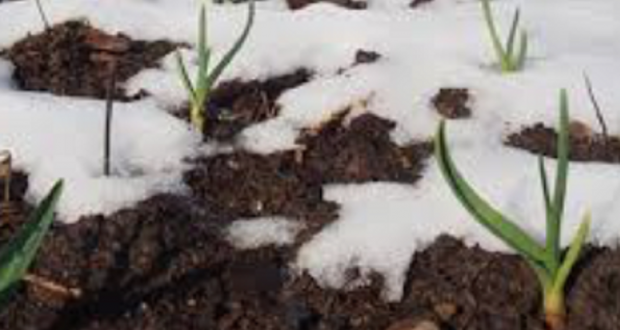By Bob Labozetta (UC Master Gardener, Mariposa)
It’s cold outside now, but there are still options for the ambitious vegetable gardener. Consider planting these six winter vegetables.
Winter lettuce selections include hardy varieties that grow easily throughout the cold months here. Direct sow lettuce seeds from mid-August to mid-September. Beyond those dates, you can sow seeds indoors in seedling trays and transplant the young seedlings about 9 inches apart in a well-prepared garden bed. Or, direct sowing in rows 12 inches apart and thin the seedlings to 6 inches apart. Harvest outside leaves often through the season, leaving those center leaves to grow for future pickings.
Arugula/Rocket is another leafy green grown in much the same way as winter lettuce. Its slightly spicy flavor is a perfect partner with lettuce. Sow indoors using a pinch of seeds per plug of 6-pack seedling trays. Transplant the young seedlings just as you would lettuce. Pinch the outer leaves simply using finger and thumb when ready to harvest up to the time plants bolt in spring.
Radishes come in multiple sizes and shapes. Try the unique winter, or Asian, varieties such as Watermelon (or Red Meat), Black Spanish, Miyashige Daikon, Minowashe Daikon, Formosa Giant Luo Buo, and China Rose Winter. Sow radishes wherever there is space in your bed and thin to six inches for winter varieties. Also, try sowing them in containers that can easily be brought inside when freezing temperatures threaten.
Spring onions (scallions) should be planted thinly in rows 6 inches apart. Thin, if necessary, to ½ inch between these alliums. Enjoy the thinnings in salads. Bulb onions, including Japanese onions, may also be planted now for early summer harvest. Onion sets can be planted as well.
Garlic comes in a surprising number of varieties. Individual cloves are directly planted in a sunny location that has rich, well-drained soil in mid-autumn. Set cloves root end down 4 to 6 inches apart in rows 6 to 8 inches apart. Cover them with 1-2 inches of fine soil. They will be ready to harvest around June.
Fava/Broad Beans are the hardiest of all bean varieties. Planted towards the end of autumn, sow the seeds 6 inches apart in 2-inch deep trenches that are 30 inches apart. Support the boundary of your growing plants with string tied to judiciously set stakes to keep them upright. You will be able to harvest the wholesome, tasty seeds by the end of spring.
There are many other vegetables that can thrive through Mariposa’s relatively mild winter season. Explore a few and find your favorites.
UC Master Gardeners of Mariposa County serve Mariposa County, including Coulterville, Greeley Hill and Don Pedro. For gardening and event information, contact them at 209-966-7078 or via email at mgmariposa@ucdavis.edu.
Find them online at http://cemariopsa.ucanr.edu/Master_Gardener/, on Facebook (UC Master Gardeners of Mariposa County), and on YouTube at “UCCE Mariposa.”
Listen to them on KRYZ 98.5 FM radio Wednesdays at 2 p.m. and Saturdays at 5 p.m.




